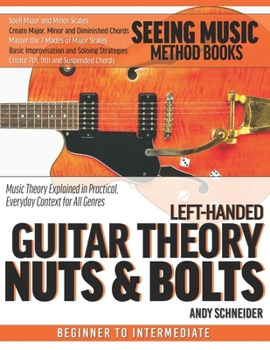Left-Handed Guitar Theory Nuts & Bolts: Music Theory Explained in Practical, Everyday Context for All Genres
Left-Handed Guitar Theory Nuts & Bolts has the theory answers you've been seeking, in plain language that links scales to chords and melodies in practical terms. It's music theory in no-nonsense form that you'll use in your own music, starting the first day.
Guitarists have a common obstacle to musical growth: understanding the basic construction of music. To progress, it's crucial to know the mechanics of music. It's music theory that's behind great music, but too often discussions of music theory get too theoretical for most of us.
AUDIO BONUS: 182 audio examples from the book for FREE download. Check yourself against the recordings for quick, confident learning. Go to SeeingMusicBooks.com
It's this EASY: Just as you can draw the basic shapes of triangle, square or circle from memory, successful guitar players can visually "draw" chord shapes on their fingerboards and move those shapes around easily, creating new music. This is the Seeing Music method of visual learning.
When you learn the simple rules that connect scales to chords, you'll be ready to create on-the-spot, anytime.Don't spend time memorizing Knowing the "Hows" and "Whys" of chord construction will let you spell them in any situation. And, it's probably much simpler than you imagine.
Learn the secrets of how scales, triads and chords are all related.Once you've seen the connection between the elements of melody and harmony, you'll never be the same. Because the concepts are fundamental, you will be applying them to any music, any style and at every level of musicianship. The best part? There's very little to memorize.
Take your music to the next level with this comprehensive guide to music theory.In Left-Handed Guitar Theory Nuts & Bolts, you will learn:
How to read fretboard diagramsHow to divide the fretboard into zones for memorizationHow to create major and minor scales, triads and chordsHow to identify any musical intervalHow to transpose a chord progressionThe relationship between major and minorHow to spell various types of 7th and 9th chordsHow to edit a chord for playabilityHow to begin improvising solos and develop soloing strategiesAll 7 modes of a major scaleHow to create your own chords and progressions from scratchHow to arrange your playing with other musiciansComplete Chapter Listing: They Hold Everything TogetherFretboard DiagramsKnow Your Fretboard (Part I)Know Your Fretboard (Part II)Major Scales, Triads and ChordsMinor Scales, Triads and ChordsIntervalsEven More Scales and ChordsSeeing the Whole FretboardHow Major and Minor Are Related7th ChordsTransposing Chord Progressions9th ChordsLeave That Note Out? Yes, You Can Chord ProgressionsBasic ImprovisingModal TheoryCreating Your Own ChordsCreating Your Own MusicPlaying with Other MusiciansYou Put It All TogetherChord and Scale ReferenceA comprehensive guide to music theory you can use. You'll enjoy this common-sense approach to the inner workings of music.Click and buy it now. Get free delivery with Amazon Prime.
130 pages, 8 1/2" by 11" paperback with glossy cover





